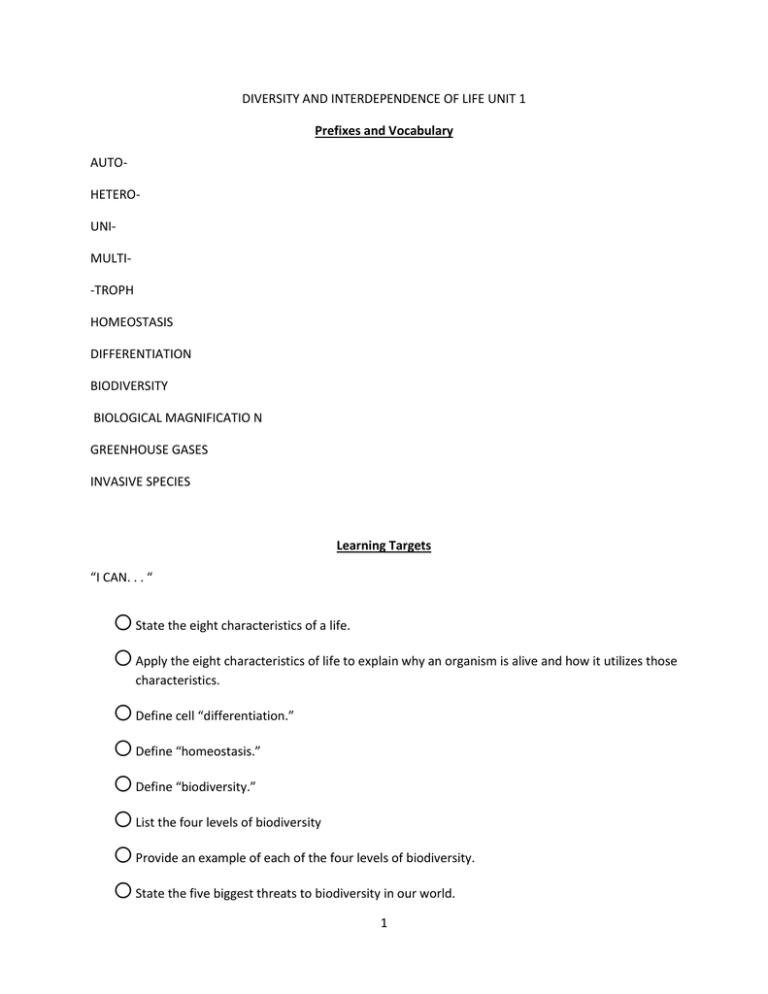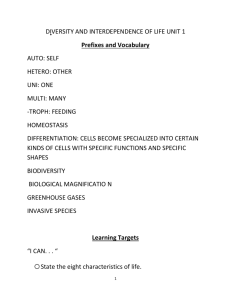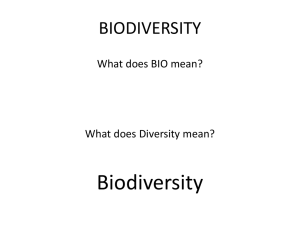DIVERSITY AND INTERDEPENCE OF LIFE UNIT 1 Learning Targets
advertisement

DIVERSITY AND INTERDEPENDENCE OF LIFE UNIT 1 Prefixes and Vocabulary AUTOHETEROUNIMULTI-TROPH HOMEOSTASIS DIFFERENTIATION BIODIVERSITY BIOLOGICAL MAGNIFICATIO N GREENHOUSE GASES INVASIVE SPECIES Learning Targets “I CAN. . . “ o o o o o o o o State the eight characteristics of a life. Apply the eight characteristics of life to explain why an organism is alive and how it utilizes those characteristics. Define cell “differentiation.” Define “homeostasis.” Define “biodiversity.” List the four levels of biodiversity Provide an example of each of the four levels of biodiversity. State the five biggest threats to biodiversity in our world. 1 o o o o o o o o o o o o o o o o o o Explain how species diversity is decreased by human disturbance under most circumstances. Create and interpret a species accumulation graph to illustrate the species richness of a habitat. Correlate the relationship between species diversity, habitat diversity and ecosystem size. Identify habitat fragmentation as having the most negative impact on biodiversity. Define “deforestation” and its impact on biodiversity. Give examples of events that destroy habitats and offer alternative solutions to those events. Simulate how the number of species on habitat islands is affected by the area effect and the distance effect; closer and larger islands to the source population have more species. Describe edge effects as the physical and biological conditions that change the habitat such that the area on the border cannot support the same species as the interior of the habitat. Analyze the effectiveness of a nature reserve by taking into account edge effects. Give a brief history of our local woods and describe the characteristics of some of the dominant plant forms in our local woods. Give examples of how non-native, or exotic, species get introduced by humans, whether purposefully or accidentally. Define an “ invasive species.” Explain how invasive species can be detrimental to biodiversity. Design an experiment to test whether or not honeysuckle, an exotic species, is also an invasive species. Define “biological magnification.” Simulate biological magnification to show how organisms at the top of the trophic pyramid are most negatively affected by toxins (Use DDT as your example). Create a bioassay to measure the sensitivity of duckweed to a wide variety of chemicals. Locate a possible source of pollutants along a river or stream and also track the water quality of the source of drinking water by making measurements periodically at the same location at different times of the day 2 o o o o o o o o o o Perform four of the nine WQI tests: (Water temperature, Dissolved Oxygen, pH, and Total Dissolved Solids) Calculate the water quality of a local body of water Give examples of the causes of atmospheric pollution and freshwater pollution Explain how the Industrial Revolution impacted the pollution levels of the atmosphere Define “greenhouse gases.” Explain how greenhouse gases contribute to global warming. Distinguish between point source pollution and nonpoint source pollution. Describe the contents of smog and how smog contributes to the formation of acid rain. Simulate different solutions to observe how hydrogen ion concentration affects pH. Interpret whether is a material is acidic, neutral, or basic using a pH sensor. 3







